Black and Orange Bugs (Pictures) – Insect and Bug Identification
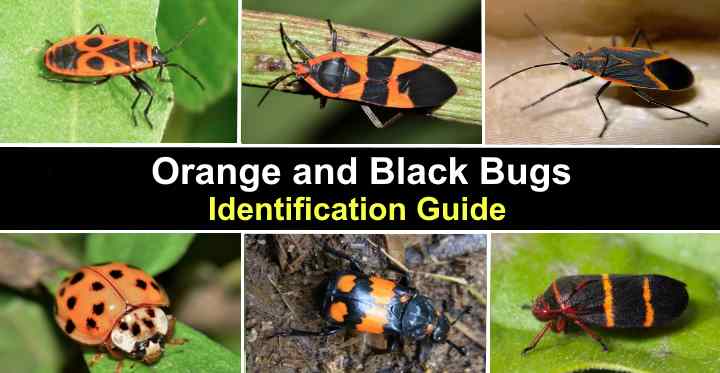
Black and orange bugs are a common sight in gardens and landscapes. These creepy crawlies come in various shapes and sizes. Some bugs with black and orange bodies, like ladybugs and beetles, can be beneficial insects. In contrast, other black and orange bugs can be nuisance pests that can bite, destroy plants, or stink when squished. Sometimes, the colorful bugs and insects can invade homes.
Identifying black and orange bugs is essential for understanding their impact on your garden. It’s also vital to know if small critters with orange and black coloration can be dangerous in the house.
This article provides pictures and descriptions of black and orange bugs to help with insect and bug identification. You can learn about the different species of bugs that have black and orange markings, including beetles, weevils, stink bugs, and other insects.
How to Identify Black and Orange Bugs and Insects
Identifying black and orange bugs requires observing their color, size, shape, and markings. For accurate identification, you can also pay attention to characteristics like their wings, antennae, legs, and body structure. Also, comparing the black and orange bugs with pictures can help identify individual insects or arachnid species.
Some people use the term “bug” as an all-encompassing term for any small insect. However, not all annoying insects with black and orange bodies are bugs in the scientific sense. “True bugs” are six-legged insects belonging to the order Hemiptera. These arthropods have piercing mouthparts to bite and suck the juice from plant tissue.
The article refers to all types of six-legged insects as bugs, whether classified in the order Hemiptera or not.
Types of Orange and Black Bugs (With Pictures) — Identification Guide
Let’s look in more detail at various types of bugs, beetles, and insects with black and orange coloration.
Boxelder Bug (Boisea trivittata)
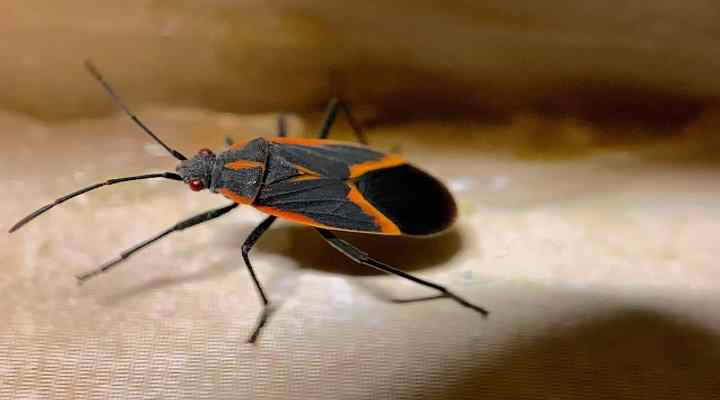
Boxelder bugs have a flat black body with orange-reddish markings
The boxelder bug is a small black insect with distinctive orange-red markings on its abdomen and wing veins. The black and orange bug has a flattened, shield-like body with an eye-catching bright reddish-orange V-shaped marking on its back. Adult boxelder bugs measure about 0.5” (12 mm) long.
Boxelder bugs belong to the order Hemiptera. They are considered nuisance pests in homes as they search for shelter in the fall. The problem with the black and orange critters is that they create red stains on carpets, drapes, and upholstery. Additionally, the nasty intruders bite into houseplant stems, feeding on their juices and harming their health.
Also called box bugs or box beetles, the black and orange pests do not damage structures or harm humans. However, most people want to eliminate adult boxelder bugs from their homes because they emit a foul stench, and their feces leave unsightly stains on clothing or soft furnishings.
The best way to get rid of boxelder bugs is to prevent their access into homes in late summer and fall. Therefore, you should seal around window frames and doors, remove wood piles and debris near your home, and use window and door screens. Additionally, you could remove boxelder trees from your property to stop the nuisance pest from laying eggs where boxelder nymphs live.
Black and Orange Bug Identification
The boxelder bug can be identified by its black body with distinct orange lines on its wings. It has a flat, shield-shaped body and is commonly found on boxelder trees, hence its name.
Large Milkweed Bug (Oncopeltus fasciatus)

Large Milkweed Bug (Oncopeltus fasciatus)
The large milkweed bug is a distinctive orange and black insect that feeds on milkweed plants. The adult bug has a vibrant orange body with a black patch on the thorax, a wide black stripe that crosses the center of its body, and the lower part of the wings is also black. It also has a slender body, long antennae, and black legs.
The milkweed bug is easy to mistake for the boxelder bug, and the adult bugs measure 0.5” (12 mm) long. The baby milkweed bugs are bright orange with black spots on their rounded bodies.
Milkweed bugs are commonly found in North America, especially in areas where milkweed plants grow. It feeds on the seeds of milkweed plants and can often be seen clustered on the plants. Large milkweed bugs are not harmful to humans, but they can be pests when they damage milkweed plants in gardens.
Black and Orange Bug Identification
The large milkweed bug has a flattened orange body with distinctive patterns of black band and diamond-shaped patches on its body.
Harlequin Ladybug (Harmonia axyridis)
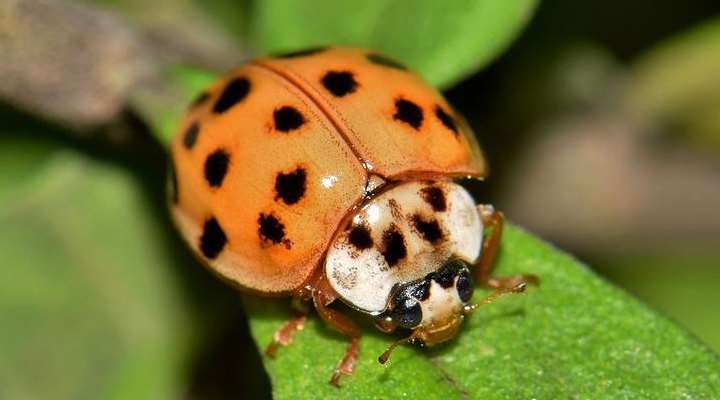
The Asian harlequin lady beetle has rounded orange body with black spots, however there are color variations and some black spots
The harlequin ladybug is a small black and orange beetle. The small bug has a characteristic domed shape with orange elytra and black spots. Other variations of the ladybug species are black wing covers and orange-red dots. The bug’s most distinctive identifying feature is the ‘M’-shaped mark behind its head.
Also known as the Asian lady beetle, the black and orange bug measures 0.21” to 0.33” (5.5 – 8.5 mm). This Asian ladybug species is larger than native species in North America and can become an invasive species. Indoors, the harlequin ladybug is considered a pest. It stains fabrics when crushed or frightened, emits foul odors, and can bite humans.
However, Asian lady beetles are beneficial insects for controlling aphids on crops.
Black and Orange Bug Identification
The harlequin ladybug is easily recognizable by its domed shape and vibrant orange, or red elytra covered in black spots. The number and pattern of spots can vary among individuals.
Hadda Beetle (28-Spotted Potato Ladybug – Henosepilachna vigintioctopunctata)
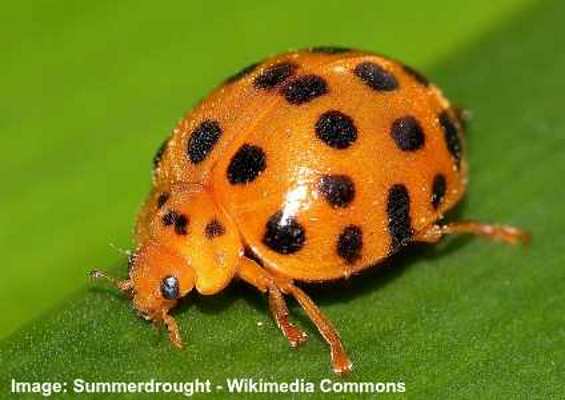
The small hadda beetle is an orange ladybug with black spots and is considered a garden pest
The hadda beetle is identified by its bright orange body with many black spots on its rounded elytra. The small orange potato ladybug has a distinct heart shape and a relatively stout, short head.
Unlike some species of ladybugs, this orange beetle is considered a garden pest as it feeds on the foliage of potato plants and other plant leaves in the nightshade family Solanaceae.<
Black and Orange Bug Identification
The 28-spotted ladybug is identified by its rounded orange wing cases covered in small black spots.
Firebug (Pyrrhocoris apterus)
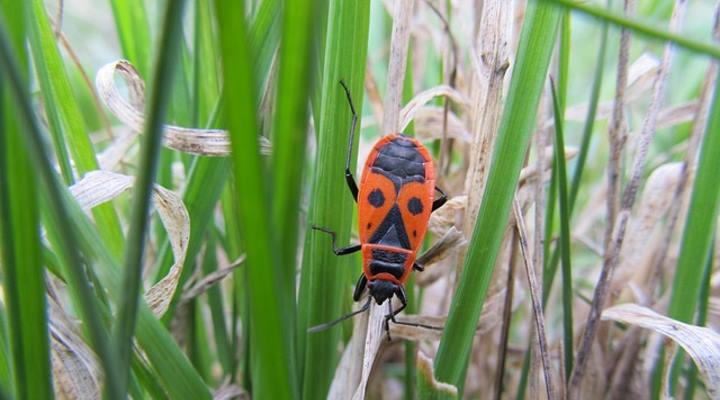
Firebugs can be easily identified by their orange-reddish body with black round spots and triangular markings
The firebug is a small, brightly colored insect with distinct black and dark orange patterns on its body. The orange-red wing covers have a large triangular marking and two spots on each side. Like most species of “true bugs,” it has a shield-like body shape, slender antennae, and a small round head.
Black and orange firebugs measure 0.35” to 0.47” (9 – 12 mm). These orange-red and black bugs are commonly found in gardens, woodlands, and meadows, where clusters of them feed on plant sap. Due to their vibrant, colorful elytra, the bugs are easy to spot on plants.
Black and Orange Bug Identification
The firebug is a small orange and black insect with circular and triangular markings on its flattened orange elytra.
Convergent Lady Beetle (Hippodamia convergens)
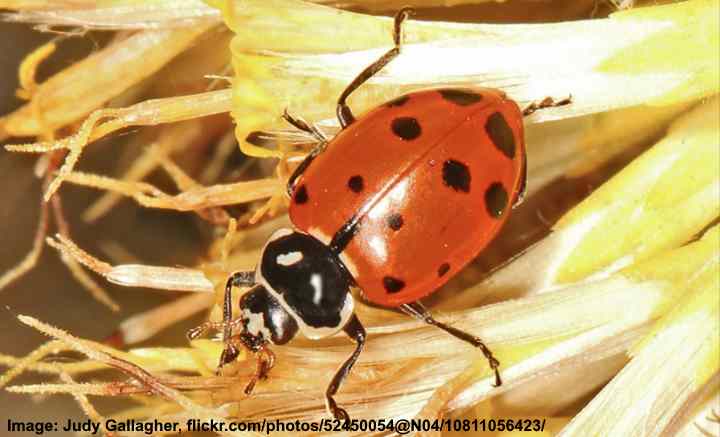
The orange-red and black convergent ladybug is the most common type of ladybug in North America
The convergent lady beetle is a small round dark orange beetle with black spots on its wing covers. Like most species of ladybugs, this beetle has a dome-shaped body, a black head with white markings, and small antennae. The number of spots can vary, but they usually have 12 black spots—six on each wing cover.
Convergent lady beetles are a species native to North America. They measure 0.16” to 0.27” (4 – 7 mm). The small orange and black bugs are beneficial insects as they feed on aphids, mites, and other soft-bodied insects that attack plants.
Black and Orange Bug Identification
The convergent lady beetle is a small beetle with a rounded shape and bright orange elytra. It has black spots on its wing covers and is common throughout North America.
Earth-Boring Scarab Beetle (Bolbocerasoma spp.)
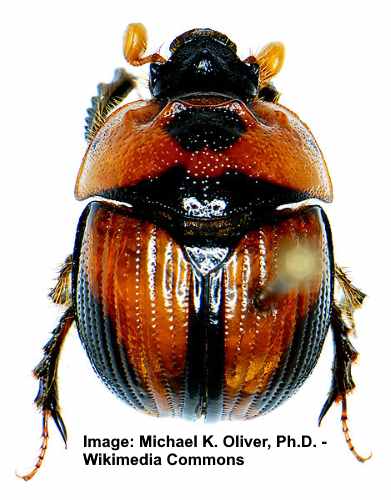
The earth-boring scarab beetle (Bolbocerosoma tumefactum) is a small orange and black beetle with yellow antennae
The earth-boring scarab beetles are a diverse group of robust orange and black insects. The soil-inhabiting orange beetles are characterized by their large, robust, hairy bodies, black markings on their backs, horn-like bumps near their heads, and yellow-orange, clubbed antennae. They measure 0.40” to 0.55” (10 – 14 mm) long.
The distinctive feature of these earth-boring scarabs is the modified arm-like structures near their head that help them to dig. The beetles feed on decaying plant material and animal dung, helping to improve the nutrient value of soil.
Black and Orange Bug Identification
Earth-boring scarab beetles are identified by their large, robust body shape, dark orange bodies with distinctive black bands, and two antennae with yellowish-orange plate-like structures. They also have prosterna—arm-like structures for digging.
Banded Net-Winged Beetle (Calopteron discrepans)
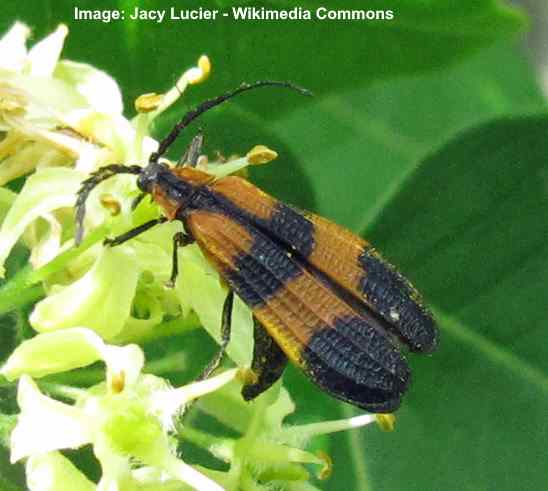
The banded net-winged beetle has long orange and black wing covers and black long antennae
The banded net-winged beetle is an orange and black beetle with large arching black antennae. The beetle is identified by its long, slender body with alternate orange and black bands across its elytra. It has an orange thorax with a black line in the middle and black legs.
This black and orange beetle is native to the eastern United States and Canada. The adult beetles measure 0.40” to 0.60” (10 – 15 mm). You will often see the colorful bug resting on vegetation in woodlands. Its vibrant orange and black colors are a warning sign to predators.
Black and Orange Bug Identification
The banded net-winged beetle can be identified by its wide black and orange bands across its wedge-shaped wing covers. Its long segmented antennae and slender body are also distinguishing features.
American Burying Beetle (Nicrophorus americanus)
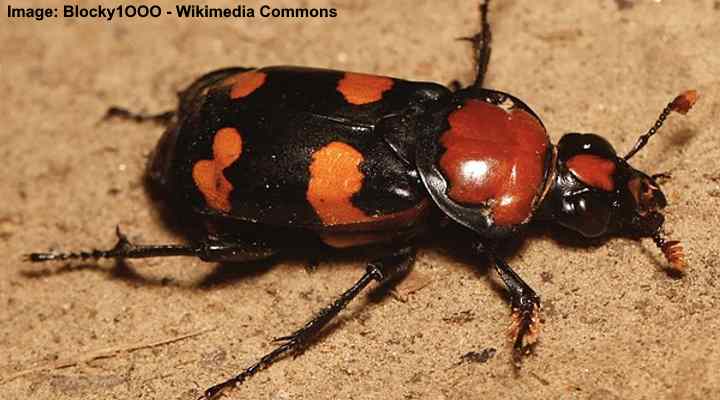
The black and orange American burying beetle has unusual antennae with orange tips
The American burying beetle is a shiny black insect with irregular orange splotches on their elytra. Identifying features of the black and orange beetles are the orange clubs on the short antenna, black legs, black head, and a bee-like buzzing sound. The large black and orange beetles measure 1.0” to 1.77” (25 – 45 mm) long.
Many species of burying beetles are characterized by their black or dark brown coloration and distinct orange markings on their elytra. The beetles, native to North America, get their name from their behavior of burying small dead animals, such as birds or rodents.
Burying beetles play an important role in the ecosystem by helping carcasses to decompose and recycle nutrients. The orange and black insects are not dangerous to humans and are generally considered harmless insects.
Black and Orange Bug Identification
The American burying beetle is recognized by its shiny black elytra with orange markings. Its black head has a red patch and easily recognizable black antennae with orange clubbed tips.
Cocklebur Weevil (Rhodobaenus quinquepunctatus)

The small cocklebur weevil has a little black head with long snout and black patterns on its orange-red body
The cocklebur weevil is a small, black beetle with distinctive orange-red elytra and round black spots on its back. Its identifying characteristics are an elongated, oval body shape, clubbed antennae, and a distinctive long snout. The small orange and black weevil measures about 0.2” to 0.3” (5 – 7 mm) long.
As its name suggests, the cocklebur weevil feeds on cocklebur, sunflower, ironweed, and ragweed plants. The weevil’s larvae bore into the stems of the plants, while the adults feed on the leaves and flowers. The small, long-snouted weevils are common throughout the United States.
Black and Orange Bug Identification
The cocklebur weevil is identified as a small orange weevil with black spots, an arching snout, and six legs.
Mediterranean Red Bug (Scantius aegyptius)
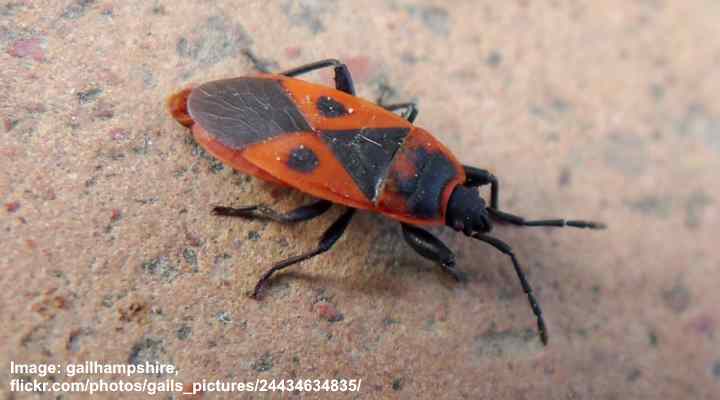
The Mediterranean red bug is very similar to firebug and both belong to the family Pyrrhocoridae, but the firebug has 2 extra tiny black dots
The Mediterranean red bug is a small black and orange-reddish insect with a distinctive elongated oval shape. The orange-red elytra has two black spots, a triangular and shield-shaped marking. Additionally, the bug has a rounded head, thin antennae, and stocky legs. The small bugs measure 0.27” to 0.35” (7 – 9 mm) long.
The Mediterranean red bug is an invasive bug common in California. The immature bugs are generally entirely orange-red and develop black spots as they mature.
Black and Orange Bug Identification
The Mediterranean red bug is easily recognized by its bright orange-red color and black markings on its shield-shaped body.
Italian Striped Bug (Graphosoma italicum)
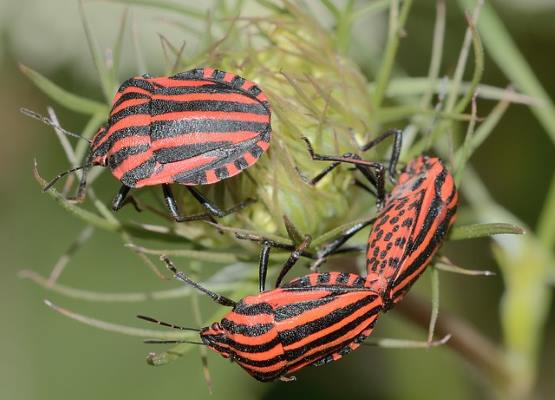
The small Italian striped bug has a shield shaped body with alternating black and orange-reddish stripes
The Italian orange-black striped bug is a small insect with a shield-shaped body and alternating black and orange stripes. The bug has a distinctive triangular shape with a pointed head and rounded abdomen. It measures about 0.31” to 0.47” (8 – 10 mm) long.
The Italian striped bug can be found feeding under the flowers of plants in the family Apiaceae —parsley, carrot, celery, hemlock, and hogweed. The black and orange stripes of the Italian striped bug are a warning sign to predators.
Black and Orange Bug Identification
The Italian striped bug, also known as the minstrel bug, is easily recognized by its orange and black striped pattern on its elytra and body in the shape of a large shield.
Two-Spotted Stink Bug (Cosmopepla conspicillaris)
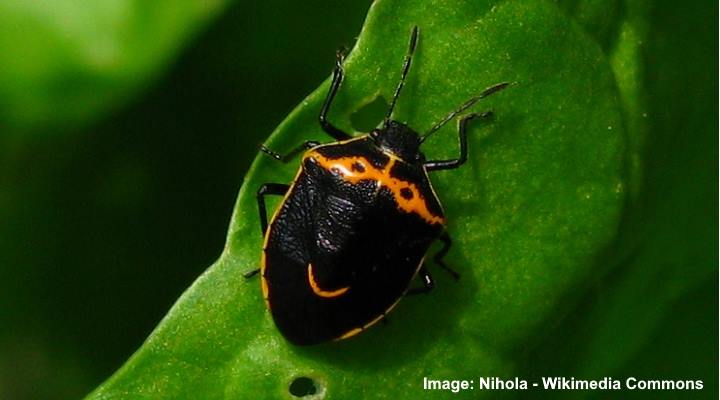
The two-spotted stink bug has a black shield shaped body with orange band and two black spots
The two-spotted stink bug is a small black insect with a distinctive orange band below its head and thin orange lines along its margins. Identifying features of the stink bug are its shield-like body shape, orange markings, and foul odor it emits when threatened or crushed. The black bug measures 0.23” (6 mm) long.
Another common name for the two-spotted stink bug is the happy bespectacled stink bug. This refers to the orange and black spectacle-like markings and the orange semi-circle resembling a smile on its back.
Black and Orange Bug Identification
The two-spotted stink bug is identified by its black body and distinctive spectacle-like orange markings at the top of its abdomen, as well as a U-shaped orange marking on its back.
Two-Lined Spittlebug (Prosapia bicincta)
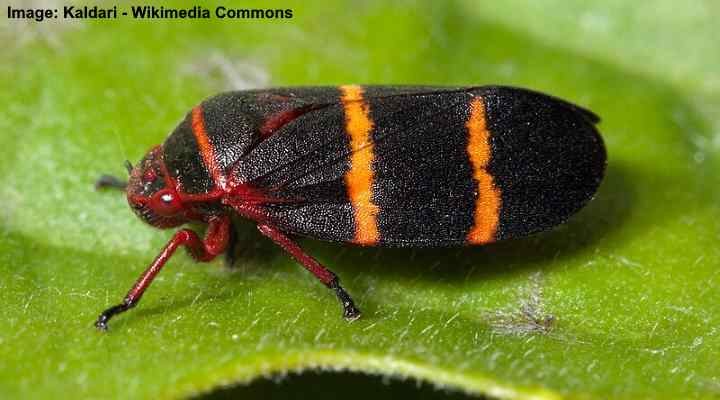
The two-lined spittlebug gets its name from the two orange lines on its black body
The two-lined spittlebug is a small black insect identified by two bright orange stripes across its elytra. Native to the Eastern United States, the black, orange-striped bug has a slender body, red legs, and a rounded red head. The black and orange bug measures 0.23” to 0.27” (6 – 7 mm) long. It can sometimes damage ornamental plants and shrubs in gardens.
Its name—spittlebug—comes from the foamy mass it secrets while feeding. It can also leap great distances and is related to a group of insects called froghoppers.
Black and Orange Bug Identification
The two-lined spittlebug is a small black bug with two distinctive orange stripes across its wings and a deep red stripe at its thorax. It has large dark red eyes and a dark red body.
Harlequin Cabbage Bug (Murgantia histrionica)
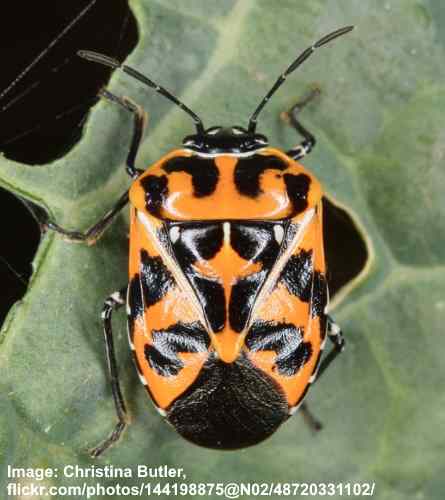
The black and orange harlequin cabbage bug is a garden pest that feed on brassica crops
The harlequin cabbage bug is a shiny black bug with vibrant orange markings on its back. This orange and black bug has a black mark at its tail end and a V shape pattern on the elytra. Like many black and orange bugs, the insects are poisonous to birds. They measure 0.37” (9.5 mm) long.
As its name suggests, the harlequin cabbage bug is a pest of cabbage and other crops in the Brassicaceae family. It also goes by the names fire bug, harlequin bug, and calico bug.
Black and Orange Bug Identification
The harlequin cabbage bug is easily recognized by its bright orange and black coloration. Its elytra are orange with black markings, and its head and thorax are black.
Orange Assassin Bug (Gminatus australis)
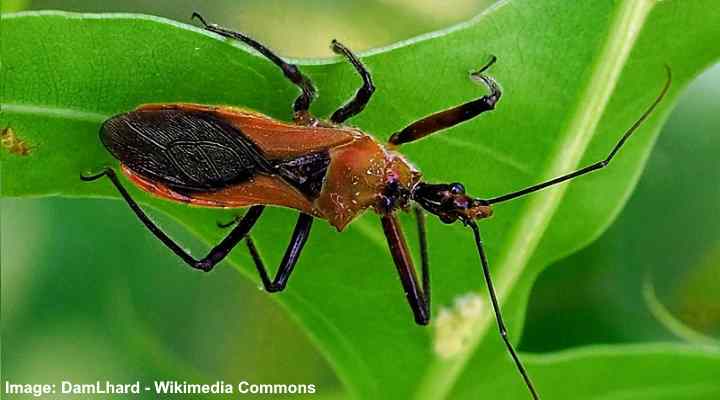
The orange assassin bug has distinctive black markings on its body and black legs and antennae
The orange assassin bug is a small predatory insect with a deep orange body and a large black vase-shaped marking on its wing covers. The orange and black bug is identified by its narrow, elongated shape, pointed head, and thin, thread-like antennae. It’s a small bug that measures 0.40” (10 mm) long.
The orange assassin bug is known for its powerful bite, which it uses to immobilize and feed on other insects. Therefore, it’s a beneficial insect to help control pest populations.
Black and Orange Bug Identification
The orange assassin bug is easily recognizable by its deep reddish-orange color and elongated body shape. A distinctive black mark on its wing covers makes it easy to identify in gardens.
Florida Predatory Stink Bug (Euthyrhynchus floridanus)
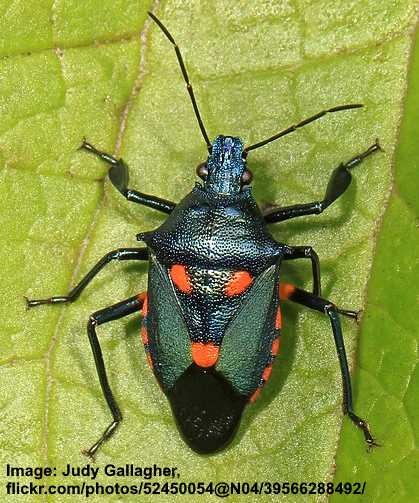
Florida predatory stink bug can be identified by its 3 orange spots on its back
The Florida predatory stink bug is a type of black or dark blue shield bug with three bright orange spots on its back. The large bug is identified by its bluish-black color, orange dots along its sides, and “Y” shape with orange tips. The large, menacing-looking bug measures 0.5” to 0.7” (12 – 17 mm) long.
Black and Orange Bug Identification
The Florida predatory stink bug is easily identified by its triangular greenish-black or bluish-black body, orange spots on its sides, and three orange spots on the elytra.
Orange Colorado Potato Beetle (Leptinotarsa decemlineata)
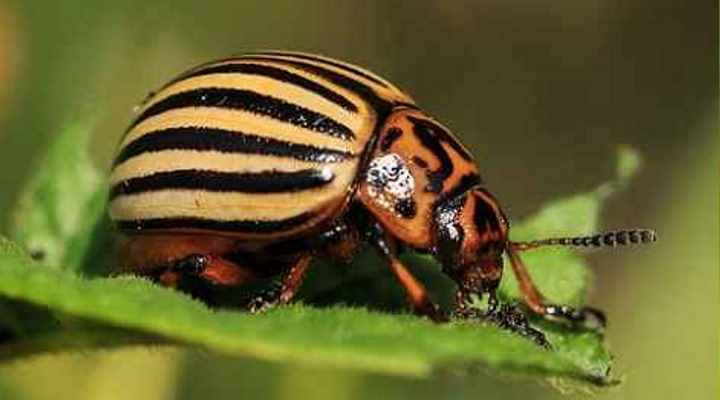
The Colorado potato beetle has black and light orange stripes along its rounded small body
The small Colorado potato beetle has a hard-shell with pale orange and black stripes, and an orange thorax and head with black markings. These black and orange striped beetles have a domed shape and an oval body and measure 0.24” to 0.43” (6 – 11 mm).
The Colorado potato beetle can do extensive damage to potato crops, as well as eggplants, tomatoes, peppers, ground cherry, and other nightshade crops.
Black and Orange Bug Identification
Orange and black striped Colorado potato beetles have distinctive stripes along their rounded elytra. They also have a flattened orange and black head and clavate-shaped antennae.
Common Red Soldier Beetle (Rhagonycha fulva)
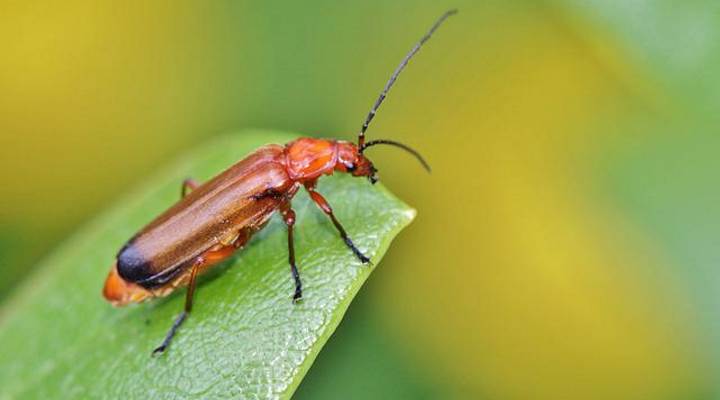
The common red soldier beetle is identified by its dark orange-red body with black patch at the rear
The common red soldier beetle is a small orange-reddish beetle with a distinctive black marking on its wing tips. It is further identified by its slender flat body, black antennae, shiny orange head and thorax, and orange and black legs.
The common red soldier beetle measures 0.3” to 0.4” (8 – 10 mm) long. Due to its dark orange-reddish color, the beetle is called the bloodsucker beetle. However, this beetle is harmless and doesn’t bite humans.
This orange beetle is considered a beneficial insect because it feeds on aphids and insect larvae. The beetle is active in summer, where its primary habitat is grasslands.
Black and Orange Bug Identification
The common red soldier beetle is identified by its elongated dark orange body with a black tip.
Goldenrod soldier beetle (Chauliognathus pennsylvanicus)
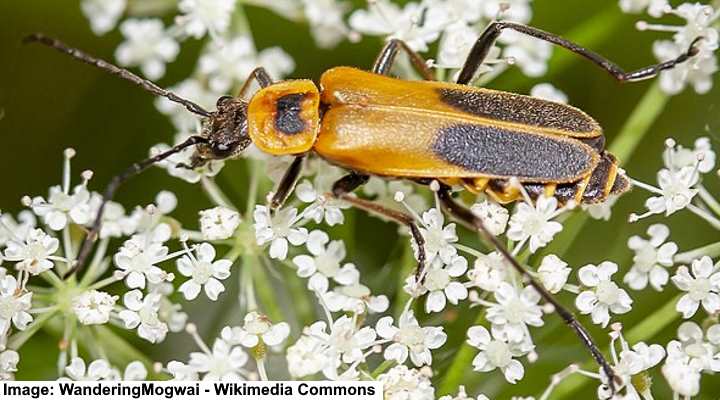
The goldenrod soldier beetle has an orange elongated body with black patches on the wing covers and thorax
The slender orange goldenrod soldier beetle is commonly found in North America and is most active during summer, where it is commonly found on goldenrod flowers and other late-flowering plants. This beetle has a distinctive black patch on each wing cover, a black mark on its orange thorax, and a black head. It also has long black legs
Also called the Pennsylvania leatherwing, goldenrod soldier beetles measure 0.62” (15 mm) long. During the fall, the beetles and their larvae live in the soil.
You will find goldenrod soldier beetles in grassy fields, meadows, and woodlands. These orange and black beetles also feed on caterpillar eggs and aphids, making them beneficial beetles.
Black and Orange Bug Identification
The goldenrod soldier beetle has two elongated brown-black oval markings on its orange elytra, making it easy to identify. It also has a long, slender appearance.
Flower Longhorn Beetle (Steneltytrana emarginata)
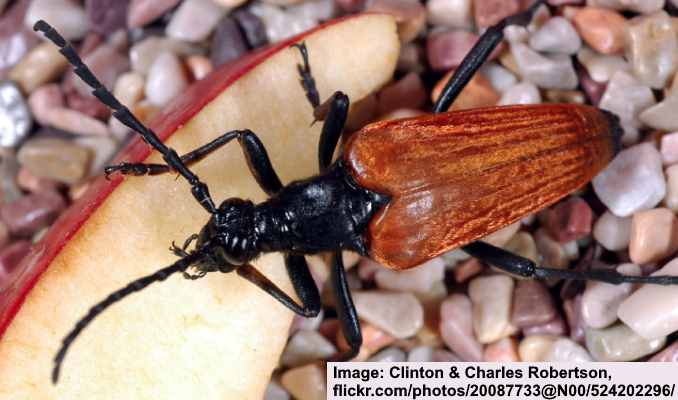
The elongated flower longhorn beetle is identified by its black head and thorax and orange wing covers
The flower longhorn beetle has a slender body with dull orange wing covers and a black thorax and head. The orange and black beetles are identified by their long antennae and elytra that create a distinctive triangular shape. These beetles are common throughout North America.
The orange and black flower longhorn beetle measures 1” to 1.37” (25 – 35 mm) long. They are usually found on flowers or feeding on fermenting fruit.
Black and Orange Bug Identification
The flower longhorn beetle is characterized by its orange triangular elytra, elongated black thorax, rounded black head, and two long black antennae.
Six-Spotted Neolema Beetle (Neolema sexpunctata)
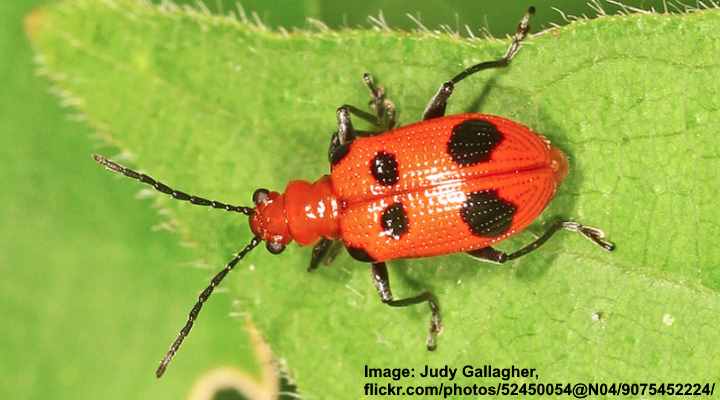
The six-spotted neolema is a small beetle with orange-reddish body and black spots
The six-spotted neolema is a small beetle with an orange-reddish body and three black spots on each wing cover. It has a dark orange thorax and head, two pronounced black eyes, and two filiform antennae.
The tiny six-spotted neolema beetle measures 0.23” to 0.35” (6 – 9 mm) and resembles an orange ladybug. The orange beetle is common throughout the eastern United States and is typically found on spiderwort and dayflower plants.
Black and Orange Bug Identification
The identifying features of the leaf-eating six-spotted neolema beetle are its shiny orange-red wing covers with black dots, six black legs and long black antennae.
Soft-Winged Flower Beetle (Anthocomus equestris)
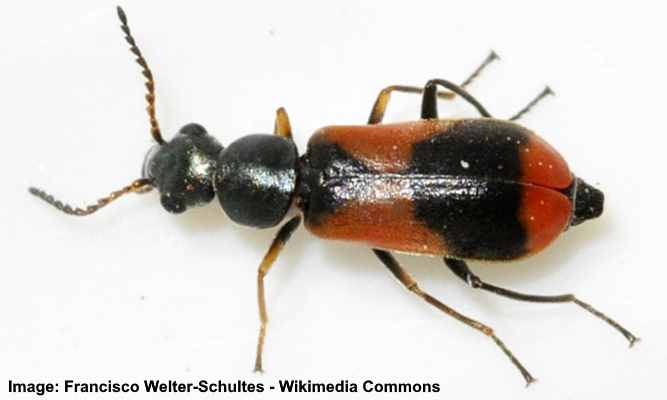
The soft-winged flower beetle has black head and thorax and orange and black wing covers
The small soft-winged flower beetle is an orange and black beetle with an elongated shape, round thorax, and bulging eyes on its black head. This beetle has a broad black band across its wing covers, triangular black mark behind the thorax, and a black tail end. Additionally, the tip of its black abdomen extends beyond the orange wing cases.
The orange and black beetle measures 0.35” to 0.6” (9 – 15 mm) long, and is not a pest in the garden. It typically feeds on the flowers of herbaceous plants during the summer, and can enter homes in the evenings because they are attracted to lights.
Black and Orange Bug Identification
The soft-winged flower beetle is identified by its broad black band across its dark orange elytra, black head, thorax, and antennae.
Spotted Asparagus Beetle (Crioceris duodecimpunctata)
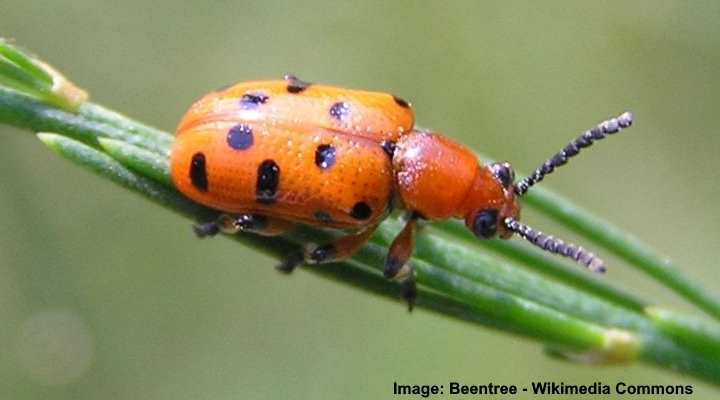
The spotted asparagus beetle is recognized by its small orange body and black spots as well as short black antennae
The spotted asparagus beetle is a small orange-reddish beetle with black spots on its elytra that could be easily mistaken as a traditional ladybug. This beetle has an oval shape with an orange thorax, head, orange and black legs and two bulging black eyes. The orange beetle has relatively thick filiform antennae.
The spotted asparagus beetle measures 0.19” to 0.25” (5 – 6.5 mm) long. These beetles feed on asparagus plants and crops in the gourd family, and are considered a significant crop pest in some regions.
Black and Orange Bug Identification
The spotted asparagus beetle has characteristic black spots on its bright orange elytra and bulging black eyes on the front of its head.
Hibiscus Harlequin Bug (Tectocoris diophthalmus)
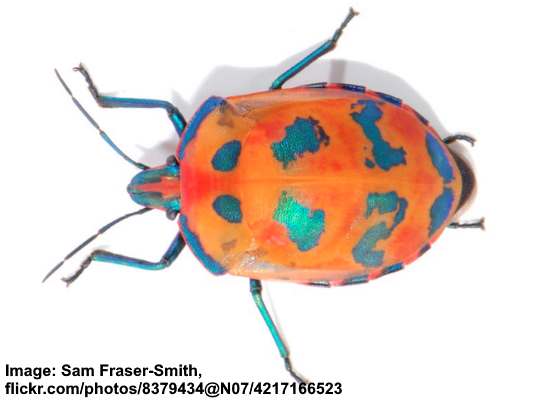
The hibiscus harlequin bug has an oval orange flat body with dark iridescent spots
The hibiscus harlequin bug is identified by a broad oval shape of a flattened shield. The females are mostly orange whereas males are orange with metallic greenish-black patches. The bugs also have metallic bluish-green legs and antennae and a small blue and orange head.
The iridescent orange and greenish-blue beetles measure around 0.78” (20 mm) long. The orange beetles use their mouthpieces to pierce tender plant tissue and suck the sap from young shoots. They feed on plants like cotton, okra, hollyhock, mallow, bottlebrush plants and linden trees.
Black and Orange Bug Identification
The hibiscus harlequin has an oval shape and bright orange and irregular iridescent blue-black patches on its back, whereas the females have a dominant orange color.
Milkweed Assassin Bug (Zelus longipes)
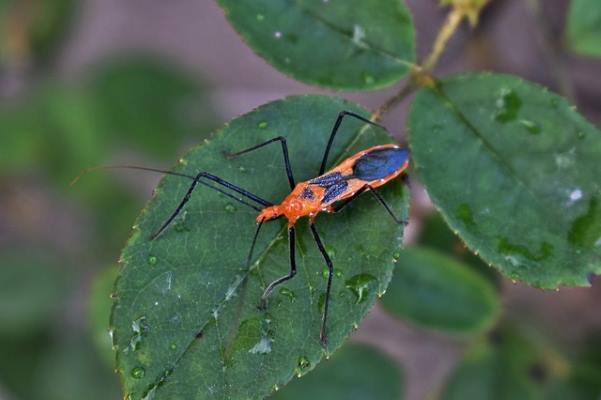
Milkweed assassin bug can be identified by its distinctive orange-reddish and black colored body, very long antennae and legs
The slender milkweed assassin bug is a brightly-colored orange insect with black patches on its body. The orange bugs have long, thin black legs and long antennae. The milkweed assassin bug also has a distinctively orange elongated body and tiny orange head. The black and orange bugs measure 0.5” (12.7 mm) long.
Milkweed assassin bugs can be found in gardens and grasslands in North America, and are considered beneficial insects because they prey on mosquitoes and caterpillars. As with all assassin bugs, these black and orange insects ambush their prey before biting them with their piercing and sucking mouthparts. Although the milkweed assassin bug is not aggressive, it can bite if you handle it.
Black and Orange Bug Identification
The milkweed assassin bug has distinctive black marks on its bright orange elongated body.
Orange Assassin Bug (Pselliopus barberi)
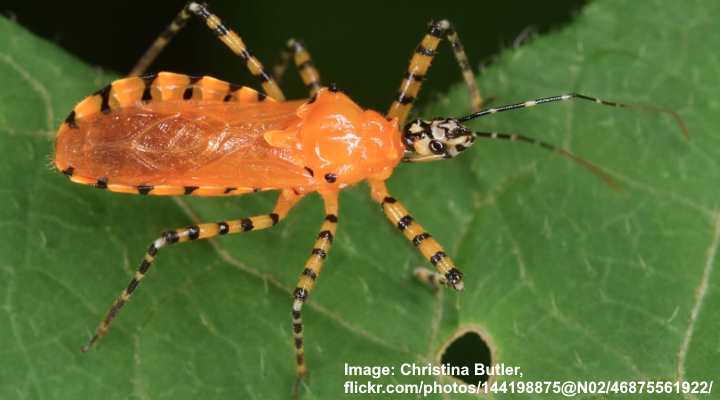
The orange assassin bug has an oval body with black and orange striped legs
The orange assassin bug has a flattened oval abdomen and distinctive, black-striped orange legs. This striped bug also has black marks around its edge and two black antennae with pale bands. The orange assassin bug measures 0.50” (12.7 mm) long.
Orange assassin bugs typically inhabit grass and woodlands and feed on wildflowers and ornamental plants.
Black and Orange Bug Identification
The orange assassin bug has a bright orange body with black marks around its abdomen and black and orange striped legs.
Leaf-Footed Bug (Spartocera fusca)
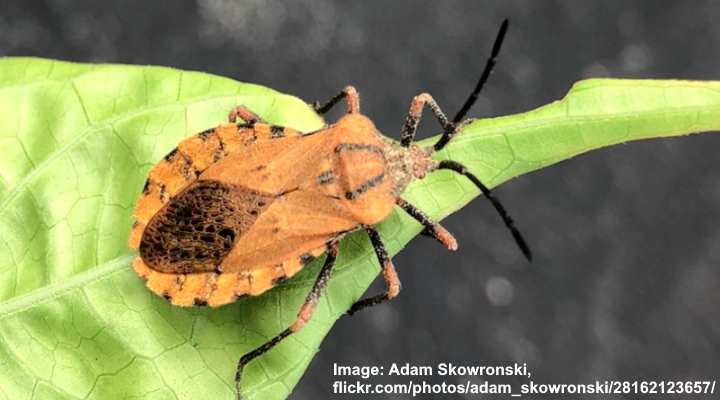
The leaf-footed bug has a flattened body and can be pale or dark orange with a black marking on its back
The leaf-footed bug varies in color from pale orange to deep orange-colored bug with a distinctive flattened oval body. This leaf-feeding insect has black stripes around the margins of its abdomen, as well as an oval blackish patch on its back.
The orange leaf-footed bug measures 0.78” to 0.94” (20 – 24 mm) long, and can be found feeding on potato plant leaves and other plant foliage from the nightshade family. However it isn’t a significant garden pest despite feeding on crops.
Black and Orange Bug Identification
The leaf-footed bug is identified by its pale-orange or darker orange, broadly oval, flattened body with black markings, as well as orange and black legs.
Orange Seed Bugs (Spilostethus pandurus)

The small orange seed bug is identified by its orange and black body and a brown patch on its tail end
The orange seed bug has a bright orange and black coloration with two wavy bands on its thorax, and an ‘X’ shaped pattern on its abdomen. It also has a black band crossing its back, and a brown tail end.
The orange seed bug measures 0.51” to 0.60” (13 – 15 mm) long. It feeds on the seeds of many plants, and although it’s not a significant pest in gardens, the orange seed bug can attack peanut, tobacco, and sunflower plants.
Black and Orange Bug Identification
The orange seed bug has distinctive black wavy bands on a brightly-colored orange elongated oval abdomen.
Related articles:
